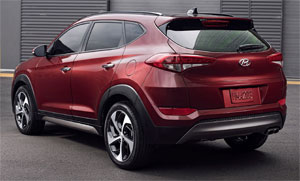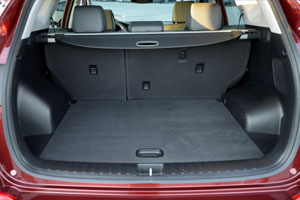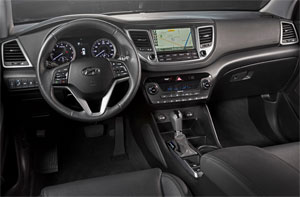2016 Hyundai Tucson
So far, Hyundai has resisted taking a plunge into the rapidly expanding pool of pint-size subcompact crossovers. But, that’s understandable as their quart-size Tucson compact ute delivers a lot more space for about the same price. Well now there’s a new Tucson, and that more for less aptitude just got even bigger.
The Hyundai Tucson has been around long enough to play a major role in Hyundai’s growth, from upstart act to Broadway box office smash.
For 2016, introducing a little more razzle-dazzle to the audience is a good play, and one consistent with most recent Hyundais. The front looks very big and bold for a compact crossover ute, and there are lots of lines flowing from there to the rear.
It very much looks like a scaled down Santa Fe, and when in Limited trim, with 19-inch wheels and LED headlights, it should help reel in those “elusive but highly sought after” younger buyers.
 Dimensions have been stretched over last year, it’s both longer and wider; and of course that translates to more room in the cabin for both people and parcels.
Dimensions have been stretched over last year, it’s both longer and wider; and of course that translates to more room in the cabin for both people and parcels.
Base engine is a 2.0-liter I4 with 164-horsepower and 151 lb-ft. of torque. Up level trims get a smaller, but stronger, 1.6-liter I4 with turbo assistance that spins up 175-horsepower and 195 lb-ft. of torque.
It also adds a 7-speed Dual Clutch Transmission, while the 2.0-liter makes do with a traditional 6-speed auto. Both engines can be had in front and lockable all-wheel drive with active cornering control.
At our test track, our turbo equipped Limited felt spirited, but far from muscular off the line; with trips to 60 taking a mundane 8.4-seconds. Torque is pretty good down low, running out of steam at the high end; but it’s certainly adequate for a compact ute. The ¼-mile pass took 16.5-seconds at 86 miles-per-hour.
 As for the DCT transmission, it proved adequate, with some occasional hesitations to get going from a stop. We also got a “high transmission temp” warning during our track day. Braking distances averaged a short 120-feet from 60; but with a long travel from the squishy pedal.
As for the DCT transmission, it proved adequate, with some occasional hesitations to get going from a stop. We also got a “high transmission temp” warning during our track day. Braking distances averaged a short 120-feet from 60; but with a long travel from the squishy pedal.
The chassis feels willing and able, with a composed non-floaty feel that’s more firm than plush. But during hard corners, the “traction control monster” awakens easily, keeping you from exploiting that feeling too much.
Taking in the scenery at a more relaxed pace, the ride is surprising enjoyable. It’s noticeably quieter and more compliant than before. The last Tucson was in a word “rough”. So Hyundai’s, increased attention to ride and handling is really paying off.
As for the ever-important drive environment inside, ergonomics are great, as is seat comfort.
The smooth looking IP is dominated by either a 5.0 or 8.0-inch center touchscreen. Hyundai’s infotainment system works well, among the best in the business, and includes a standard back-up camera.
 Despite numbers that indicate there’s a bit less legroom for rear seat passengers than before, it felt plenty roomy to us. And it enabled cargo space to go way up; now 31.0 cubic-ft. behind the standard split-folding rear seats, 61.9 cubic-ft. with them folded. That’s 20% more than the average subcompact ute.
Despite numbers that indicate there’s a bit less legroom for rear seat passengers than before, it felt plenty roomy to us. And it enabled cargo space to go way up; now 31.0 cubic-ft. behind the standard split-folding rear seats, 61.9 cubic-ft. with them folded. That’s 20% more than the average subcompact ute.
Hyundai’s hands free smart lift gate is also available.
Despite the small stature, there’s full size safety here; with an automatic emergency braking system that worked flawlessly in our barrier test. Sudden stops were abrupt enough to leave some skid marks on the pavement.
Government Fuel Economy Ratings are 24-City, 28-Highway, and 26-Combined. So our average of 26.8 miles-per-gallon of Regular was right on. The Energy Impact Score is about average for all vehicles at 12.7-barrels of oil use and 5.8 tons of CO2 emissions yearly.
And now the fine print. Base Tucson stickers for $23,595. That’s a grand more than last year. The top Tucson Limited AWD starts at $32,195.
Those higher admission prices do put a crimp in our rave review, as they are now a good deal more than a comparably equipped subcompact ute, while still less than the bestselling compacts. Still, the Tucson is fresher and better equipped. Star qualities that should impress both the critics and the masses; keeping Hyundai’s marquee shining bright.
Specifications
- Engine: 1.6 liter I4
- Horsepower: 175
- Torque: 195 lb-ft.
- 0-60 mph: 8.4 seconds
- 1/4 mile: 16.5 seconds @ 86 mph
- EPA: 24 mpg city / 28 mpg highway
- Energy Impact: 12.7 barrels of oil/yr
- CO2 Emissions: 5.8 tons/yr
2024 Toyota Land Cruiser
Toyota’s Go Anywhere Globetrotter Returns To U.S.
Every once in a while, we all need a reset. A time to get back to basics and prioritize the things that really matter. Well, for the Toyota Land Cruiser that time is now. So, let’s find out if that means bigger and better things for Toyota’s iconic off-roader.
The Toyota Land Cruiser’s status among the global off-road community is legendary, and it’s hard to imagine there’s any corner of the earth where a Land Cruiser hasn’t kicked up a little dust or mud. Well, 2024 sees the return of the Land Cruiser to the U.S. market after a 3-year hiatus, getting a major reset for the journey.
The reset comes mostly by no longer being based on the large three-row “300-series” chassis, but a new version of the smaller “200-series,” now known as the J250. As with the latest Tacoma, it uses the Tundra pickup’s full-size steel frame.
While the main Land Cruiser model, which goes by simply Land Cruiser, is packed full of luxury and convenience features, there is also a stripped-down model known as the 1958, honoring the first year the Land Cruiser made landfall here in North America. And it is that 1958 we have here, and we were glad to see it, as it also celebrates the original’s back-to-basics approach as a blank canvas for you to personalize as you tackle more and more adventures.
Not that it’s fully stripped down, as 8-inch touchscreen infotainment, a 7-inch full-color multi-information display, and automatic climate control are still standard. Plus, some seriously durable materials, and great heated cloth front seats that throw off some get serious 1990s Tacoma vibes.
But outside, there’s a definite lack of flashy trim and basic looking 18-inch wheels with Yokohama Geolander all-season tires; plus, big chunky bumpers and tilt-up back glass, which is a rarity that we appreciate. Though there is a little too much plastic in places that are sure to see some abuse if you do any significant off-roading.
It even feels a little rough around the edges, but for us it just adds to the rugged old-school utility vibe in a good way.
We did just that, both here in the Mid-Atlantic as well as in the California desert; and while there are some tech-forward driving aids, the actual hardware is in most cases plenty to get things done. That includes standard full-time dual-range four-wheel-drive, locking center and rear diffs, and 8.7-inches of ground clearance. A front stabilizer bar disconnect is also available to allow for increased articulation.
Who needs a V6 or even a V8 when you’ve got Toyota’s i-FORCE MAX setup at your disposal with 326 horsepower and 465 lb-ft of torque coming from a 2.4-liter turbo-four with an electric motor sandwiched between the engine and its eight-speed automatic transmission. Low speed torque delivery is impressive. It even feels a little rough around the edges, which may be a turn off to some, but for us it just adds to the rugged old-school utility vibe in a good way.
And it certainly feels quicker than an off roader needs to be, with an instant torque dump as soon as we eased on the throttle at our Mason Dixon test track; helping us get to 60 in 8.1 seconds and through the quarter-mile in 16.3 seconds at 86 mph. Considering the Land Cruiser’s terrain conquering mission, it behaved quite well in our handling course; it was plenty responsive to inputs, with less body roll than we expected and plenty of grip from the tires. The steering was light and quick but as expected didn’t provide much feel. Other than significant nosedive, braking performance was exceptional. Only 107-feet to panic stop us from 60 mph.
With the shift to the smaller size, there’s no more third row available, and cargo capacity now comes in at 46.2 cubic-feet with a max of a still healthy 82.1. Now, the best part of the Land Cruiser’s return is the entry price of $57,445. That’s about 30-grand less than what the last Land Cruiser went for back in 2021.
Whether it’s over the top fashion trends, mullets, or zombies; just when you think they’re dead, they come roaring back to life. Of course, we’re much happier to see the resurrection of this 2024 Toyota Land Cruiser than any of those things. Toyota is one brand that still recognizes the value of full-framed rugged rigs and has also acknowledged that sometimes less really is more. The Godfather of Toyota off-roading is back and better than ever.







